After rating little more than a curt mention in Australian cinema histories for several decades, Giorgio Mangiamele’s status as a pioneer of the Australian cinema has more recently come to receive greater recognition in a growing number of articles, both in print and online, as well as in documentaries like Nigel Buesst’s Carlton + Godard = Cinema (Australia 2003).[1] Not surprisingly, perhaps, it has been Mangiamele’s Clay, the second Australian film to have ever been invited to screen in competition in Cannes, that has often been the real drawcard of attention but in more recent times a number of writers have also turned their focus on Mangiamele’s only screen comedy, Ninety Nine Per Cent (1963).[2] The general approach to date, however, has been to interpret the film largely within the context of an articulation of migrant themes, here not only the discrimination against and the alienation of the Italian migrant in immediate postwar Australia but in particular the problem of the scarcity of marriageable women for Italian migrant men during this period. With some justification, Gaetano Rando has ranged Mangiamele’s not-quite-feature-length comedy (47 minutes) alongside films such as Luigi Zampa’s Bello, onesto, emigrato Australia sposerebbe compaesana illibata (Girl In Australia Italy 1971) and Jan Sardi’s more recent Love’s Brother (Australia 2004), both films that centre on the trials and tribulations of male Italian migrants trying to find suitable wives.[3] Raffaele Lampugnani, while largely sharing this “migrant themes” perspective in an earlier article, has more recently proposed a richer reading of the film which identifies Luigi Pirandello’s theoretical notion of “umorismo”, or sense of humour, as the philosophical basis of its bitter-sweet comedy.[4] There can be little doubt that such approaches all go some way towards appreciating the geniality of this early comedic gem but I would contend that perhaps an even greater understanding of the film – and of Mangiamele’s filmic style generally – may be gained from looking at it in more precisely cinematic terms and, even more specifically, in terms of art cinema. In what follows, then, I would like to take up Quentin Turnour’s perceptive suggestion that Ninety Nine Per Cent may actually be directed less at an Italian migrant constituency and relatively more towards a culturally cosmopolitan audience which, via institutions like the Melbourne Film Festival, would be well-versed in international art-cinema.[5] Following this line I’d like to argue that, over and above – or perhaps to the side of – a denunciation of the parlous condition of the male Italian migrant that has often been claimed for it, Ninety Nine Per Cent’s greater genius lies in its magisterial melding and reworking of a number of modes and motifs of earlier cinematic comedy, in the process weaving a web of intertextual allusion that goes from Jacques Tati and Federico Fellini to American slapstick and television sitcom. And in the interstices, I’d like to suggest, there may flit nothing less than the shadow of that tragic masterpiece of Italian neorealism, Vittorio De Sica’s Bicycle Thieves (Italy 1948).
The story
As most who have written on the film have pointed out, Ninety Nine Per Cent is about the unsuccessful attempt by an Italian widower to procure a wife for himself, and a mother for his son, by employing the services of a marriage bureau. However, given that the film has been more often talked about than seen, it would seem useful to begin with a slightly more extended account of its narrative line before going on to discuss its cinematic artistry and allusiveness.
Short, plump Italian immigrant, Joseph Pino, and his studious school-age son, Peter, share a messy, cluttered house in an inner Melbourne suburb (recognizably Carlton). Both patently miss the mother, whose photo looks down on them benevolently from a small shrine on one of the walls, if for nothing else than for her ability to keep the place clean. Largely illiterate, we soon learn, but obviously something of a successful wheeler and dealer, Pino is clearly making piles of money which we see him count and hoard away in a number of secret locations in the house. Although he maintains that the money is meant for Peter’s education, his miserliness is openly scorned by the boy who subscribes to (and quotes) Francis Bacon’s maxim that money should be used and spread around rather than niggardly saved. Whatever the source of the son’s resentment – perhaps he is converting his sense of loss for the mother into a certain hostility towards the father, perhaps he dislikes what he regards as his father’s boorishness and lack of education – it is clear that Peter does not get on with his father.
The son goes to school while the father goes off to sell a variety of wares (watches, clocks, radios, pieces of woven fabric) in the local café. As things in the café literally hot up – some of the fabric in Pino’s suitcase catches fire when a potential customer tries to test its fire-resistance – Peter comes to call his father for a meeting with the headmaster of his school, where Pino (after a comic altercation with two other men waiting to see the headmaster) learns that his diligent son has been awarded a scholarship to cover next year’s schooling. The boy’s perpetually torn pants, however, prompt the headmaster to suggest that the boy really needs a mother. Pino’s hand slides down his backside to where his own trousers are torn in exactly the same place as his son’s. The headmaster is really telling them what they – and we –already know.[6]
Back home, as Peter waits with a towel around him, Pino attempts to mend his son’s trousers, inevitably and repeatedly pricking his fingers with the needle. As he sucks on his fingers to allay the pain, a congenial elderly neighbour, whom we’ve already met, appears at the open window and is soon reiterating the by-now familiar point that Pino really needs a woman in the house. But highly conscious of his very limited physical attractiveness and well aware of what he openly admits is his distinct lack of sex appeal, Pino can see no way to achieve this aim until the neighbour draws his attention to an item in the newspaper which we’ll soon come understand is an advertisement for the services of a matrimonial agency.
Pino is soon dressed to the nines and striding along the street towards the agency, puffing on an unlit cigar in an attempt to appear a man of the world.
At the agency a less than enthusiastic Mr. Tchikowski eventually begins to take down Pino’s specifications, becoming slightly more interested once Pino is brought to estimate his own worth at 10,000 pounds.[7] Pulling out of the neatly-organised files (clearly marked Greek, Italian, German, French, English, Chinese, Russian, but also “Pygmies”, “Eskimo”, “Stateless”, and all subdivided into “blonde” or “brunette”) the photo of a certain Anastasia Coska, a woman who apparently speaks seven languages and four dialects, he tells Pino that he thinks he has found the right woman for him. Highly impressed by what he sees in the photograph (“Gee, she’s a film star!”), Pino earnestly asks the man whether he really thinks such a woman would want to marry him. Mr. Tchikowski assures him that he is 90% certain. This estimation is then increased to 99% once Pino has paid his 20 pound fee and has returned to the agency with a freshly-taken (and, clearly, slightly-doctored) photograph of himself.
Returning home, Pino is able to deflect the son’s usual hostility about the messiness of the house with the news that they will soon have “a lady” living there, someone who can love them both and look after Pino (and his pants) properly. The boy immediately brightens and picks up a broom. Heeding his son’s injunction not to stand around “acting the sentimental bloke” (clearly an allusion), the father joins the son in a frenetic round of spring cleaning during which the most varied items (an old tyre, a bicycle, some wooden boxes, a chair, a lampshade, a black cat –which quickly scuttles off) are thrown into a heap in the yard and set on fire. As a lively jazz tune plays, windows are cleaned, new furniture is bought and, as father and son move a new television set into place in their transformed living room, they appear to have achieved not only an improved living space but also a new intimacy between them. In a first demonstration of any real affection towards Pino, Peter at this point spontaneously plants a kiss on his father’s cheek.
Having arranged a suitable time to visit the prospective bride, Miss Coska, by way of a telephone call made from the neighbours’ house, Pino sits down at the new clean table in their renovated living-room to await the longed-for moment. As he continues to admire Miss Coska’s photograph with erotic glee, he begins to feel pangs of guilt provoked by the look of his deceased wife and so he strategically turns her photograph to the wall. Soon, father, with a huge bunch of flowers and now son, too, dressed to the nines, are in the street receiving the best wishes of a crowd of supportive neighbours as they set off on their quest to bring back the wife/mother they so sorely need. After a brisk walk through the streets (during which they are almost run over by a car as they dance a bit of a jig on the road) they find the address and stand awestruck for a few moments in front of the tall apartment building. Having bustled their way through a group of teenagers milling around on the front steps, Pino stops to look at two strategically-placed white masks depicting comedy and tragedy hanging on one of the pillars. Obviously feeling frisky and self-assured, Pino mockingly scowls at one and grins at the other. His grin, however, has disappeared by the time they have climbed several floors, and the overweight father only manages to make it up the last flight of stairs with his son pushing him, like an elephant, from behind.
The son remains on the landing as the father knocks and is eventually bidden to enter. Proffering the huge bunch of flowers in front of him, Pino enters the room gingerly. The mysterious Miss Coska (whom we only ever see in eroticised sections and never in full view), rises from her chair and via a high over-her-shoulder shot, which allows us to confirm that she is indeed a tall blonde, we see the stunned and fearful look in Pino’s face at the other side of the room as he looks up as though at a colossus. Extreme close-ups of Pino’s face and of Miss Coska’s eyes and mouth alternate as the tension grows and is eventually broken by loud peals of mocking laughter that come from Miss Coska’s giant mouth, now dominating the screen in repeated extreme close-ups. Peter’s face at the window, previously expectantly gleeful, becomes downcast and several drops of perspiration flow, tearlike, in mournful comment, down the streaky windowpane. Pursued by the woman’s tormenting laughter, Pino hurries out of the flat. Roughly grabbing Peter by the hand, he descends the stairs and pushes his way through the juvenile crowd still on the front steps, all of whom also begin to laugh at him mockingly.
Dispirited and dejected, father and son walk back through urban spaces that resemble the rubble-strewn landscapes of postwar Italian neorealist cinema. A flurry of what first appears to be snow turns out to be confetti being thrown at a happy wedding party emerging joyously from a local church. As father and son look on at a sight that confirms their own loss, behind them we see a young mother emerging from one of the houses with a baby in her arms. Now even more dejected, they walk into a park, past children playing on swings, until Pino sits on a bench, defeated and despondent. Squatting down beside the bench Peter uses a twig to trace a deep circle in the ground and begins to fill in the furrow with small Moreton Bay figs until he has completed a sort of necklace with the pebble-like seeds. As he plants the twig into the centre of the circle, in a gesture that highlights its perfect symmetry, the boy reaches out hopefully to take the father’s hand but Pino, still resentful at his loss and humiliation, at first pulls his own hand away. Looking up at his father with obvious love in his eyes, the boy tries a second time and this time Pino clasps his son’s hand and squeezes it affectionately. Still no wife or mother, of course, but father and son appear at least to have rediscovered each other.
It’s doubtful whether even this rather extended account can convey the full extent of the film’s narrative ingenuity. Indeed the story as we’ve just recounted it, is not the whole story, because the father/son narrative and the ill-fated visit to Miss Coska’s apartment is cleverly enclosed within, and bookended by, a repeated comic confrontation which father and son have with a lanky, lumbering, belligerent Australian drunk, falling over himself as he splutters insults and offers to fight the father. Although the father is never in any real danger, it’s significant that both times, at the beginning and at the end, it’s the boy who drags the father away to safety (the second time in the opposite direction to the first). This provides the film with something of a circular structure, a circularity which seems to be figured in the film itself by the circle/necklace that the son designs in the ground and then by the way in which this necklace, at first seen in close up, goes out of focus and then, via a swirling camera motion, cross dissolves into children holding hands and dancing a merry-go-round around the lumbering captive drunk who turns and turns until, finally breaking through their circle, stumbles away to his eternal confrontation with innocent passers-by.
Tatiesques
As Rando and others have noted, the figure of the hostile and dangerous Australian drunk appears in practically all of Mangiamele’s previous films.[8] Here, however, the threat presented by the drunk is sublated, so to speak, as he is transformed into a relatively-harmless figure of fun through the comic energies of the film, and particularly through the film’s allusions to a whole gamut of classic screen comedy. Lampugnani has rightly indicated reminiscences of both Chaplin and Laurel and Hardy in the drunk’s first confrontation with Pino and his son.[9] However, the major point of reference in the drunken sequences is surely the gestural, almost-silent comedy of Jacques Tati. Quentin Turnour was the first to indicate a certain influence of Tati in the film, especially in the very Tatiesque use of human speech as comic sound effect rather than meaningful dialogue which Turnour sees exemplified in the “somnambulant, monosyllabic exchanges” of the school board meeting at which the headmaster is presiding when Pino and Peter first arrive at the school.[10] And yet, I would argue, the influence of Tati in the film is both more extensive and more specifically identifiable. Certainly, for example, the sort of music and the way it is used in the whole film is very reminiscent of music in Tati’s films generally, thus giving the entire film a sort of Tati “feel”. At the same time Bob Clarke’s inspired performance as the drunk, with which the film opens and closes, seems to be quite specifically referencing the jerky gyrations and pirouettes of François, the postman, in Tati’s Jour de fête (France 1949).[11] And, indeed, once one begins to look at Jour de fête as a possible source text for some of the comic “business” in Ninety Nine Per Cent, one begins to note all sorts of other echoes of it in Mangiamele’s film. So, for example, if at one level, interpreted mimetically, the horse and milk-cart that the drunk encounters in the sunlit lane immediately presents us with a piece of vintage Australiana, on the other hand it also echoes the confrontations with horses and carts that bedevil the postman throughout Tati’s film. Similarly, the bent old lady coming down the steps of the marriage bureau, brandishing her umbrella like a stick and frightening Pino back to the railing, recalls quite specifically the figure of the old “goat lady” who acts as a sort of witness and commentator on all the goings-on in the village in Tati’s film. Even Pino’s throwing out of the bicycle in the spring-cleaning sequence, natural enough within the narrative context, vividly recalls the way in which the café owner in Jour de fête throws out the bicycle which the postman has ridden straight into his establishment.[12] But we must return to consider the presence of the bicycle in Mangiamele’s film in more detail presently. Clearly, it echoes the ubiquity of bicycles in Jour de fête but the allusion might extend further. For the moment, however, we could note that if the appearance of the horse and cart in Mangiamele’s film echoes the horse and cart crossing the square at various times in Jour de fête, it also inevitably brings to mind the horse and cart which insistently clip-clops its way between the new and the old districts in Tati’s Mon oncle (France 1958). And to invoke Mon oncle is not only to widen the allusive scope of Mangiamele’s comedy but also to begin to give some shape to that vague feeling of déjà vu that one experiences with the father and son in the film, a very strong feeling that one has seen this familiar couple before.
Given Mangiamele’s artisanal mode of filmmaking, it may have been pure serendipity that he was able to enlist the services of Francesco and Carmelo Pino, father and son in real life, to play the father and son of the film. Nevertheless, however it was engineered, Mangiamele’s Pino and Peter come to bear a striking resemblance to Charles Arpel and his son, Gerard, in Tati’s Mon oncle. The resemblance is visual and somatic (Pino resembles Charles Arpel physically to an extraordinary degree) but also thematic. By the end of Mon oncle it becomes clear that, despite the overwhelming presence of M. Hulot in the film, the uncle’s bumbling antics have merely served to facilitate the resolution of the real psychological conflict at the centre of the film, namely the lack of intimacy that exists between father and son, a lack that is then resolved at the end of the film when, following Hulot’s departure, the son quite naturally slips his hand into that of his father and his father reciprocates. Similarly, I would argue, the unsuccessful search for a surrogate wife and mother in Mangiamele’s film is in many ways merely the catalyst for a resolution of the real “problem” of the film, namely the distance that exists (for whatever reason) between Peter and his father, an estrangement that is then definitively reversed when the father, after that first refusal, accepts and squeezes the hand the son offers. And yet, if fathers and sons join hands at the conclusion of both these films, what one might call the locus classicus of the resolution of father/son conflict through a clasping of hands is in another film and, as with the bicycle mentioned earlier, we will need to return to it presently.
Felliniana
One could hardly approach a film that revolves around a man’s visit to a marriage bureau, especially a film from a director with a background in Italian cinema, without considering that the theme had already been treated in Federico Fellini’s Un’agenzia matrimoniale (Marriage Bureau), the episode Fellini had contributed to Cesare Zavattini’s portmanteau film, L’amore in città (Love in the City, 1954). And yet, at first sight, the films could hardly be more different.
In Fellini’s film a young man visits a matrimonial agency because he has been asked to write an article on the subject. After making his way through a labyrinth of corridors he finds himself in a crowded waiting room but manages to jump the queue by dint of special pleading. Having been brought into the office of the female director of the agency, he explains that he has come on behalf of a friend, the son of a wealthy landowner, who suffers from an unusual illness that turns him into something like a werewolf at full moon. His doctors, unable to find any effective medical treatment for the condition, have suggested marriage as a possible cure, and so the young man has come to the agency to find a wife for his friend. Clearly expecting that there could be no takers for such a bizarre offer, the young man is surprised when the agency is easily able to supply the details of a likely candidate. Intrigued, the young man takes up the offer to meet the woman, and discovers she’s a pretty but very poor girl from the country whose willingness is motivated equally by a deep sense of compassion for the suffering of others and by the economic need to support her parents and her nine younger siblings. The young man is greatly moved by the girl’s selflessness and devotion to her family but his afflicted friend is, of course, non-existent, so he can do no more than advise the girl to return to the country and her family, and to wish her good luck.
Given the all too obvious narrative differences between the films, the suggestion of any significant influence of Fellini’s Agenzia matrimoniale on Ninety Nine Per Cent would indeed seem misguided. And yet perhaps we have been looking in the wrong place. Or rather, perhaps we haven’t been looking (and listening) closely enough. Looking and listening more closely I think we discover that Fellini enters Mangiamele’s text visually and aurally, and not at the marriage bureau itself but at the film’s anti-climactic climax, at the very moment of Pino’s hapless encounter with the fearsome Miss Coska. Those insistent loud peals of mocking female laughter, those repeated extreme close ups of a fulsome but disembodied female mouth – where have we heard and seen those before?
We know that Mangiamele was an avid filmgoer and records show that one of the most popular Italian films screened in Melbourne in 1963 was Boccaccio 70 (Italy 1962), another portmanteau film which included an episode directed by Fellini and entitled Le tentazioni del dottor Antonio (The Temptations of Dottor Antonio).[13]
Made in the wake of the great success of La dolce vita (1960), Le tentazioni del dottor Antonio was Fellini’s first venture into colour. In the 50 minute film veteran Italian actor, Peppino De Filippo, plays a pontificating and rather hysterical moral zealot – Fellini was obviously satirising the moralists who professed to be so scandalised by La dolce vita – who comes to mount a crusade against a huge billboard facing his apartment featuring a generously proportioned Anita Ekberg in an advertisement cheekily encouraging all Italians to drink more milk. Becoming progressively more obsessed with eliminating the putatively offensive billboard and thwarted at every turn by the relative indifference of the other morally-upstanding citizens around him, De Filippo/dottor Antonio one night takes matters into his own hands and steals out in his pyjamas to attempt to exorcise the evil presence. At first angered and frustrated by his helplessness, he is, however, soon cowering in awe and terror as he looks up at the live giant figure of Ekberg, every inch the 50 foot woman, that has materialised from the billboard and which now, looking down on him from above, taunts him mercilessly for his hypocrisy with loud peals of malicious laughter. As De Filippo continues to look up at the fearsome if beautiful creature, the camera frequently moves in on a close-up of her face, so that her fulsome but often disembodied mouth takes up the whole screen as it continues to berate and laugh at the little man down below.
It should be clear from our earlier description that Mangiamele’s Pino (who bears a striking resemblance to Peppino De Filippo, especially in close up) is nothing like the frenzied, hypocritical moralising zealot of Fellini’s dottor Antonio, and certainly does not deserve the same castigation; nevertheless, it’s equally clear that Mangiamele has indeed borrowed some of the stylistic stratagems of Le tentazioni del dottor Antonio in staging Pino’s final and humiliating confrontation with Miss Coska.[14]
But this touch of Fellini, unmistakable but perhaps unnoticed by contemporary audiences of Mangiamele’s film, far from exhausts the film’s comic allusiveness and so, in order to explore a little further the comic intertexuality of the film, we need to return with Pino to the café.
Slapstick and American sitcom
As we’ve already seen, in the early part of the film Pino takes himself and his suitcase of wares to the local café. As the wonderful be-boppy “Little Collins Street” plays on the juke-box, he attempts to ply his trade, engaging first with a moon-faced simpleton of a young man in overalls who is nevertheless firm in resisting Pino’s offerings from an ever increasing range of wristwatches. The scene is done in the style of silent comedy with just a slight touch of slapstick. There’s classic comic accumulation as Pino, with a saleman’s grin, pulls out first one, then two, then three, then four wristwatches, none of which seem to attract his intended customer. Pino then decides to pull out an alarm clock and the client seems slightly more interested but as he touches it, the alarm goes off, and the man jumps back in exaggerated fright, grabbing his hat from his head and holding it tight before him. But Pino has understood; bigger is obvious better than many, so bending down, he extracts a large wall-clock from his suitcase and this time, success! The customer’s face lights up, he nods and finally hands over his money.[15]
Noticing the big wad of cash the man is carrying around in his torn trouser pocket, Pino quickly attempts to also sell him a piece of fabric from his suitcase. He points to the label, which we see in close up: “Pure Austrelian Woul”, the misspelling playfully conveying both Pino’s poor literacy skills and approximating in writing how an Italian migrant might pronounce the phrase. It also suggests, of course, that it may not be the real thing. The joke gets bigger. Pino attempts to show the prospective customer that it really is “pure wool” by trying to set it alight with his lighter and failing to do so (we see later in the film that Pino’s lighters generally don’t work). However, as he is called away to supply a small radio to another customer at the back of the café, the simpleton in overalls uses matches and does succeed in setting the fabric on fire. Rushing back, Pino stuffs it all inside the suitcase with embarrassment and hurriedly leaves, joined at the door by Peter who has been waiting for him. As they walk briskly along the street towards the school, Pino decides to abandon the smoking suitcase in the gutter, explaining to Peter: “It wasn’t my suitcase anyway”.[16]
But leading up to the burning cloth and the consequent hurried exit from the café is one of the funniest and most interestingly-shot scenes of the entire film (missing from the most commonly-viewed shorter bersions of the film). In trying to find a place for Pino to lay open his suitcase to display his wares, the café manager, who is obviously in league, goes over to a table occupied by three bearded “beatnik” types. He berates them for sitting there for hours over just one coffee. “Where should we go?” asks one of them, rather dim-wittedly. “Go to work”, says the café manager forcefully. “Work!” exclaims one, almost puzzled. ”Work?!”, exclaims the other, almost scandalised. “Work”, they all repeat as the camera takes them from directly below the table. Slowly, unwillingly, they rise from the table and leave. The presence of these duffle-coated beatnik types in the film at this point may be an attempt by Mangiamele to gently satirize the pseudo-intellectuals of the Carlton café scene in the early 1960s.[17] What’s most interesting, however, is to note that the satire is carried out through a specific allusion to the popular and long-running American sitcom, The Many Loves of Dobie Gillis, which featured a resident and dull-witted beatnik, Maynard G. Krebs, who inevitably reacted with terror to any suggestion of doing anything (apart from sitting around and being “cool”) with the scandalised expression, “Work!?!”[18]
And… Bicycle Thieves?
As the foregoing analysis of just some of the comic allusions in Mangiamele’s film should suggest, Ninety Nine Per Cent is far from being simply a humourous rendition of migrant themes and indeed is much more like a sophisticated exercise in cineliteracy. And, intriguingly, what opens up in the light of the film’s previously unrecognised but patently complex allusive intertextuality, is the possibility that perhaps the ultimate exploit of Mangiamele’s sophisticated comedy may be nothing less than a fleeting but definite homage to what was, reputedly, his favourite film, namely Vittorio De Sica’s Bicycle Thieves.
As we’ve already seen, as part of the spring cleaning of the house (almost exactly halfway into the film), Pino throws a bicycle out into the courtyard, thus echoing the gesture of the café proprietor in Jour de fête, who twice throws the postman’s bicycle out of his locale. This is immediately preceded by a interior shot showing Pino picking up and shouldering the bicycle. Perhaps natural enough as part of the narrative one might say, but there’s a strange familiarity to this shot. Where have we seen it before? A moment’s reflection will confirm its uncanny reminiscence of Antonio shouldering the bicycle as he and his son leave the house on that fatal day in Bicycle Thieves. As fleeting as this visual echo undoubtedly is, it is then built on and re-confirmed by that final gesture of Peter, like Bruno, offering his hand to his humiliated father, and thus affirming not only familial love but father and son’s solidarity in and against a cruel world. It must thus seem significant that, in the very final sequence, in a repeat of the confrontation with the drunk, Peter does not lag behind at a distance from the father, tying his shoelaces as he did at the beginning (another echo of Bicycle Thieves?), but rather this time father and son confront the drunk, and the world, together.
This reference to Bicycle Thieves would thus be the jewel in the crown, so to speak, of a rich web of allusive intertextuality that marks Mangiamele’s film as a highly cineliterate and self-conscious exercise in screen comedy. This is no doubt what Mangiamele meant when he said in his final interview, only a few weeks before his death: “My aim was always to make art films”.[19]
Illustrations
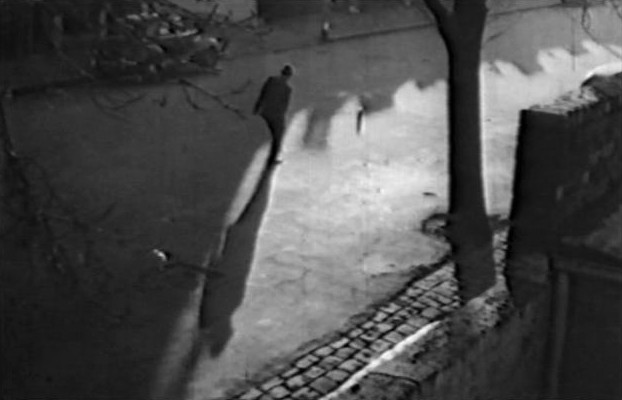
Ninety Nine Per Cent: Bob Clarke as the drunk – opening sequence
(courtesy NFSA/Rosemary Mangiamele)
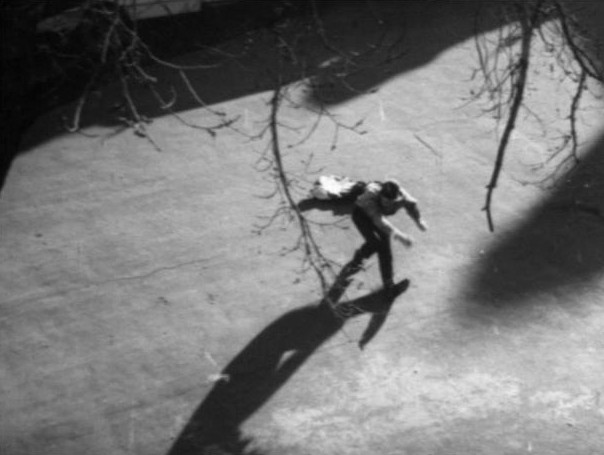
Ninety Nine Per Cent: Bob Clarke as the drunk – final sequence
(courtesy NFSA/Rosemary Mangiamele)
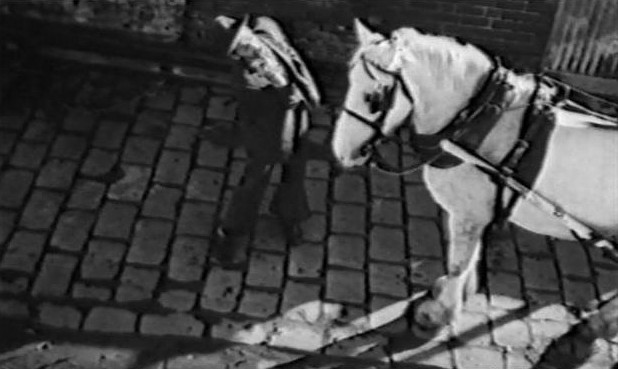 Ninety Nine Per Cent: the drunk’s confrontation with the horse
Ninety Nine Per Cent: the drunk’s confrontation with the horse
(courtesy NFSA/Rosemary Mangiamele)
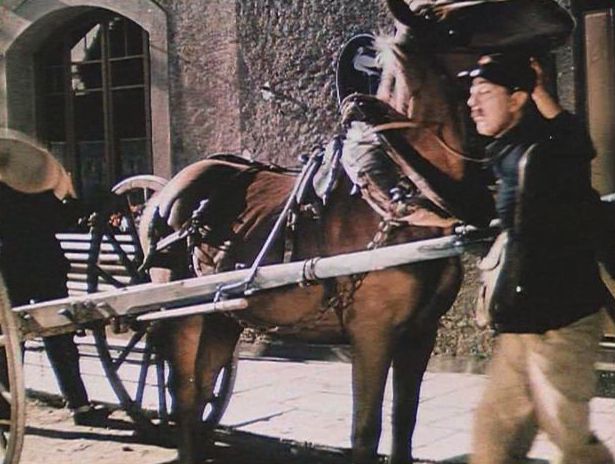
Jour de fête: one of François’ confrontations with horses
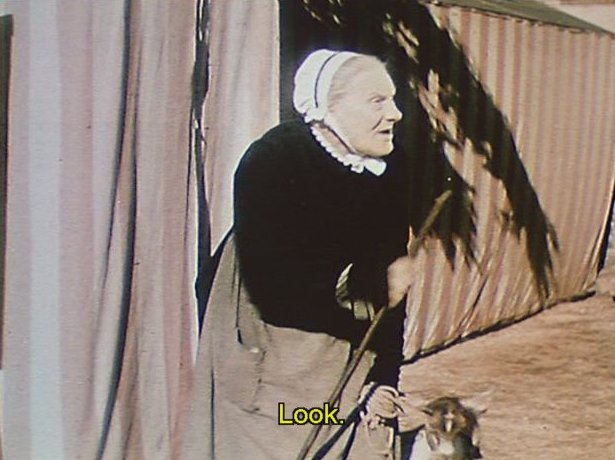
Jour de fête: the “goat woman”
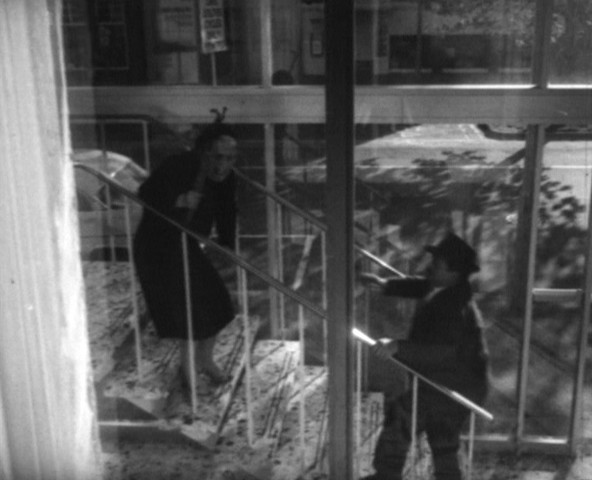
Ninety Nine Per Cent: Old woman on steps outside marriage bureau
(courtesy NFSA/Rosemary Mangiamele)
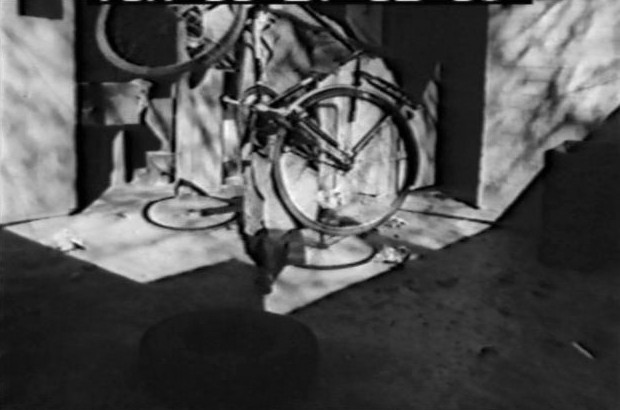
Ninety Nine Per Cent: Pino throwing out the bicycle
(courtesy NFSA/Rosemary Mangiamele)
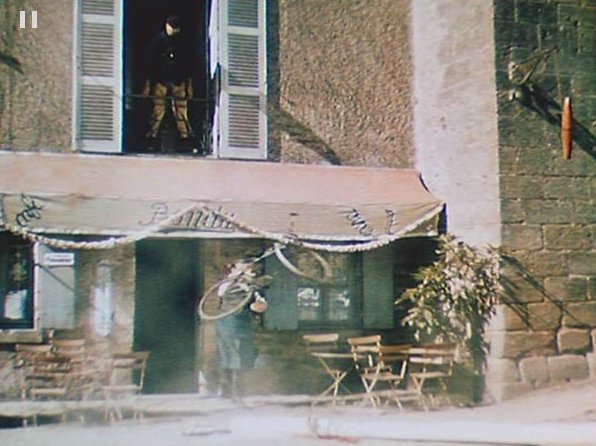
Jour de fête: café owner throwing out Francois’ bicycle
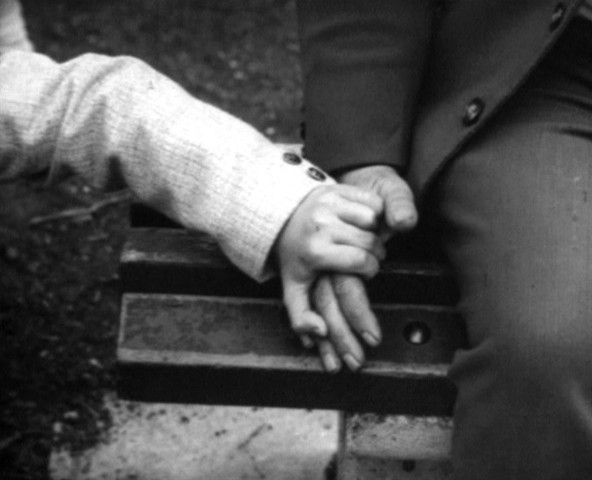
Ninety Nine Per Cent: Peter offering hand to his father
(courtesy NFSA/Rosemary Mangiamele)
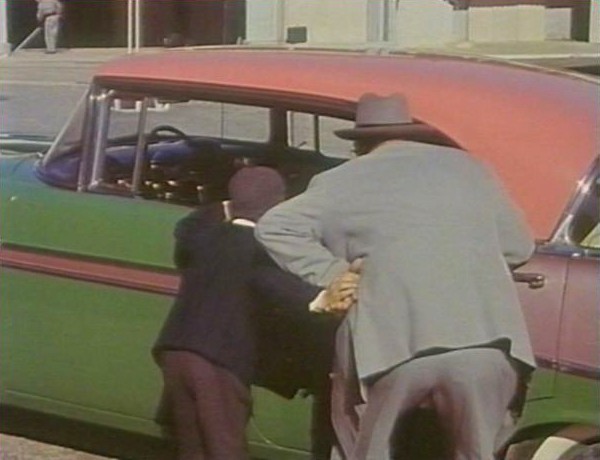
Mon oncle: Gerard offering his hand to his father
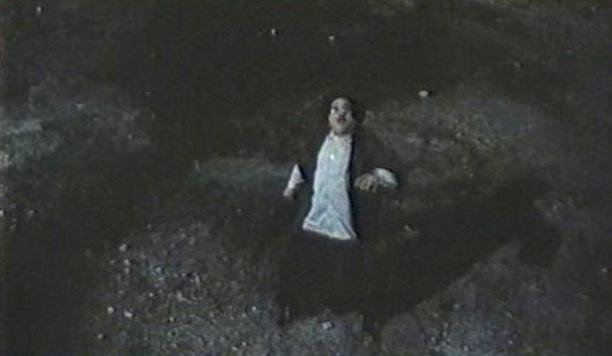
Federico Fellini: Le tentazioni del dottor Antonio
Antonio looking up at the giant Anita Ekberg
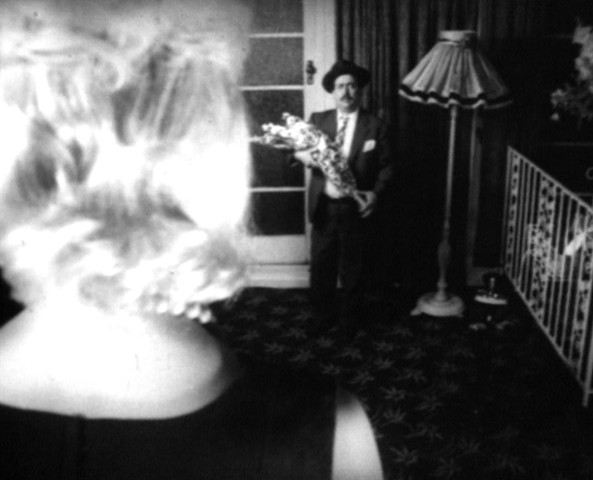
Ninety Nine Per Cent: Pino looking up at Miss Coska
(courtesy NFSA/Rosemary Mangiamele)
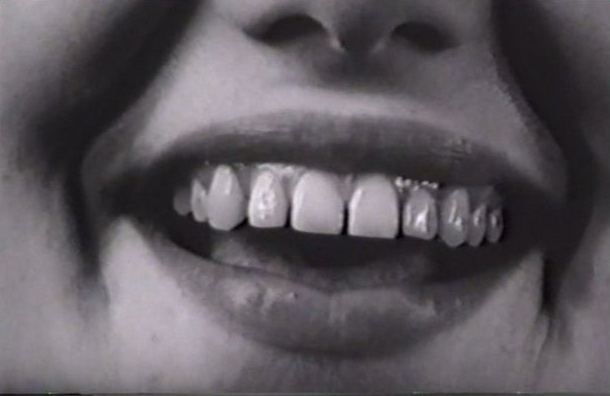
Ninety Nine Per Cent: Miss Coska’s laughing mouth
(courtesy NFSA/Rosemary Mangiamele)
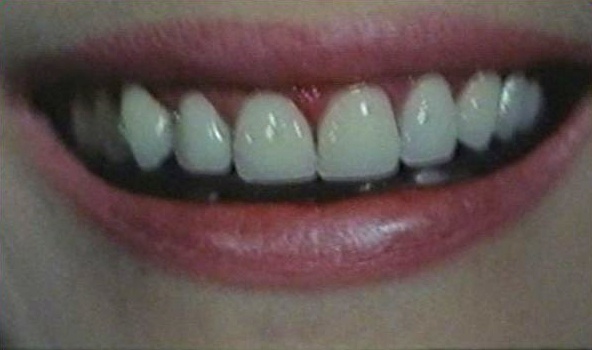
Fellini: Le tentazioni del dottor Antonio
Anita Ekberg’s laughing mouth
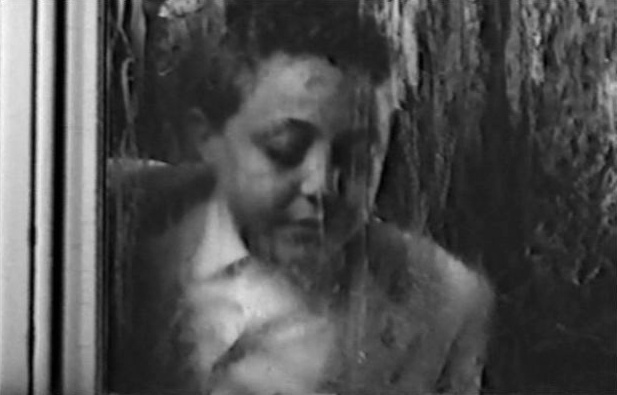
Ninety Nine Per Cent: Peter downcast at his father’s plight
(courtesy NFSA/Rosemary Mangiamele)
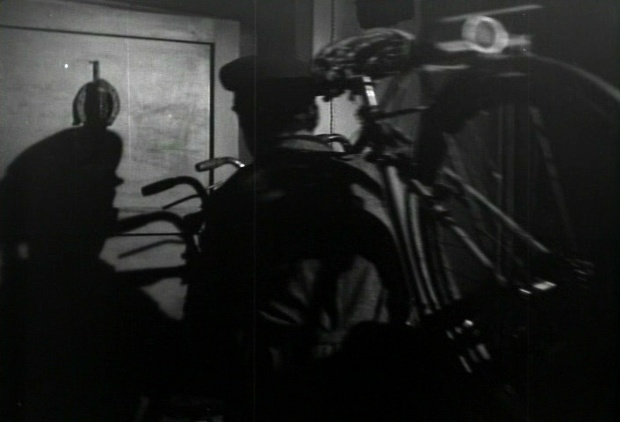
Vittorio De Sica: Bicycle Thieves
Antonio carrying his bicycle out of the room
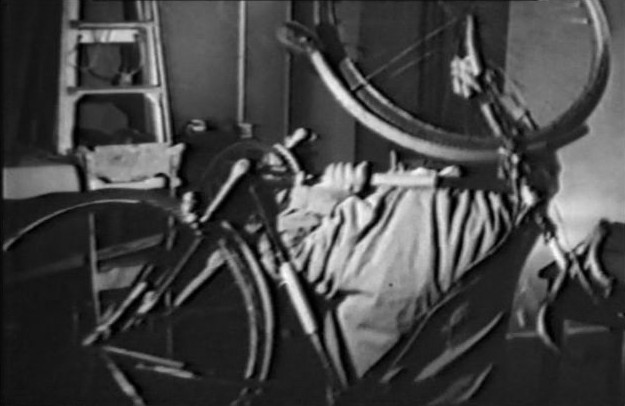
Ninety Nine Per Cent: Pino carrying the bicycle out of the room
(courtesy NFSA/Rosemary Mangiamele)
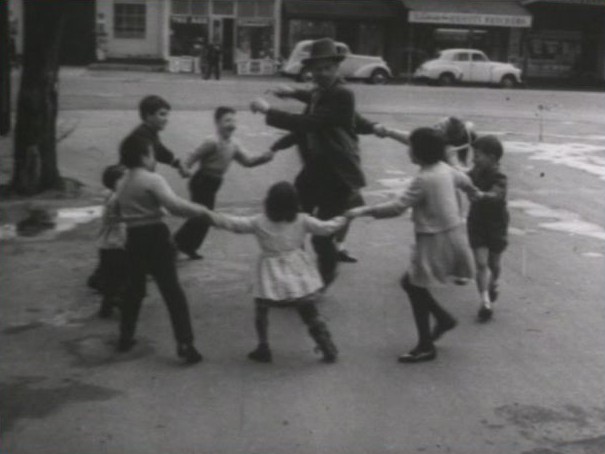
Ninety Nine Per Cent: drunk caught in children’s merry-go-round
(courtesy NFSA/Rosemary Mangiamele)
Endnotes
[1] The literature on Mangiamele has been steadily growing since the early 1990s. A first major step in recognising Mangiamele’s place in Australian cinema was made with Graeme Cutts’ “Interview with Giorgio Mangiamele” in Cinema Papers, 90 (1992). In the same issue John Conomos discussed Mangiamele’s work extensively in his article, “Cultural Difference and Etnicity in Australian Cinema”. A brief entry on Mangiamele subsequently appeared in The Oxford Companion to Australian Film, edited by Brian McFarlane, Geoff Mayer and Ina Bertrand (Melbourne/Oxford: Oxford University Press, 1999). However, what perhaps remains the most perceptive appraisal of Mangiamele’s work and its place in Australian film history came only after his death in 2001 with Quentin Turnour’s “Giorgio” in Senses of Cinema, issue 14 (2001), [available online athttp://archive.sensesofcinema.com/contents/01/14/mangiamele_quentin.htm] which amplified a shorter article first published as a C-teq Annotation in Metro 112 (October 1997). A number of other assessments appeared around the same time: Alex Castro, “A profile of Giorgio Mangiamele”, in Senses of Cinema, issue 4 (2000) [online http://archive.sensesofcinema.com/contents/00/4/giorgio.html], Graeme Cutts, “Giorgio Mangiamele”, on the Australian Independent Filmmakers web page (May 2003) [now also available online athttp://archive.sensesofcinema.com/contents/00/4/giorgio.html] and Scott Murray, “Giorgio Mangiamele – Passionate Filmmaker, 13 August 1926 – 13 May 2001” in The Age, May 22, 2001 [now available online athttp://archive.sensesofcinema.com/contents/01/14/mangiamele_obit.html]. A strong interest in Mangiamele’s work has also developed in Italy, as borne out by the focus on his work in the recent Sguardi australiani: idee, immaginari e cinema degli antipodi, edited Silvana Tuccio (Genova: Le Mani, 2005).
[2] In particular see Raffaele Lampugnani’s “Depicting the Italo-Australian migrant experience Down Under: Images of estrangement in the cinema of Giorgio Mangiamele” in Rita Wilson and Susanna Scarparo (eds.),Studi d’Italianistica nell’Africa australe / Italian Studies in Southern Africa, vol. 18, no. 1 (2005) and “Comedy and Humour, Stereotypes of the Italian Migrant in Mangiamele’s Ninety Nine Per Cent”, Fulgor, vol. 3, no. 1 (December 2006) [now available online athttp://ehlt.flinders.edu.au/deptlang/fulgor/volume3i1/papers/Lampugnani_v3i1.pdf]; and Gaetano Rando’s “The Representation of the Italian Australian Diaspora in the films of Giorgio Mangiamele with particular reference to the two versions of The Spag”, in La diaspora italiana dopo la Seconda Guerra Mondiale / The Italian Diaspora after the Second World War (Bivongi, Italy: AM International, 2007) and “Liminality, temporality and marginalization in Giorgio Mangiamele’s migrant movies”, in Studies in Australasian Cinema, vol. 1, no. 2, (2007).
[3] Gaetano Rando, “Liminality, Temporality and Marginalization “, p. 214.
[4] Raffaele Lampugnani, “Comedy and Humour”.
[5] Characterising it as “Giorgio’s best [film]”, Turnour writes: “The film’s comic pleasures address the divergent cosmopolitanism of Carlton in the ‘60s rather than the exclusive picaresque of the Italian community there (and Giorgio’s film co-incidentally observes the changes overtaking the suburb in the post-war period)”. In “Giorgio”.
[6] Rando (“Liminality”, p. 8) reads the headmaster’s comment as an accusation being made against the lone migrant parent of not being able to look after his son properly but this is probably an overzealous attempt to discover hostility against the Italian migrant by the host culture even where it may not exist. Indeed, the headmaster actually excuses himself before venturing to make the comment: “It’s not for me to say but you need a woman in the house”.
[7] Lampugnani (“Depicting the Italo-Australian migrant experience Down Under”, p. 60) is convinced that Pino is lying about his wealth but there’s no real indication in the film that he is. He appears to take a moment to calculate his own worth before replying to Mr. Tchikowski’s question.
[8] Rando (“Liminality”), p. 10.
[9] “Depicting the Italo-Australian Migrant Experience Down Under”, p. 61
[10] Turnour’s point is valid enough although there’s also a great deal of humour in what we hear the somnambulant board members actually say. The last 3 statements, made by different members, before the headmaster exits to meet Pino and son are: “I will”; “I wouldn’t”; “I have to”.
[11] One is strongly and immediately reminded of that early sequence where François descends from his bike and twists and turns on himself as he tries to swat the bee buzzing around his ears but also, of course, of his movements later on in the film when the postman actually is drunk.
[12] The café owner throws the bicycle out twice, the first time about 12 minutes into the film, and the second at about 29 minutes.
[13] See the report in The Film Weekly, August 29, 1963, “Boccaccio 70 sets new Melbourne records” (p. 6). Thanks to Adrienne Tuart for her help in tracking down the film’s run in Melbourne in 1963.
[14] Perhaps it was in order to make up for the extra (and thus unfair) moral abjection of Pino that is operated by associating him with Fellini’s dottor Antonio in this way, that Mangiamele then shot Peter’s witnessing of his father’s humiliation in an almost religious tone. Indeed, the shot of Peter downcast at the window as Miss Coska’s devilish laughter continues to resound seems almost like a composition from The Crucifixion, the documentary on the silver bas-reliefs of the Stations of the Cross by Matcham Skipper which Mangiamele had shot for Tim Burstall in January 1963, and thus immediately before embarking on Ninety Nine Per Cent.
[15] One wonders whether, even in all this comedy, there may not be an allusion to the old man trying to sell off his watch in Vittorio De Sica’s Umberto D (1952).
[16] The burning of the “pure woul” is slapsticky but also “Tatiesque” to the extent that it seems to engage with the same warped logic we see Hulot apply in the Arpel’s kitchen in Mon oncle. There Hulot accidentally drops the plastic jug and expects it to break but lo! it bounces back, like a ball, into his hands. Wonderment! Well then, in order to confirm this order of things Hulot intentionally lets drop a crystal glass and stands, hand waiting, for it to rebound. It shatters. Embarrassed, Hulot attempts to move the broken glass under the cupboard with his foot.
[17] My thanks to Federico Passi for suggesting the allusion.
[18] Beginning in January 1961, the popular teen sitcom ran for almost 3 years on Melbourne commercial television (Channel 9). Mangiamele’s daughter, Claudia, has stated in an email that her father was never particularly interested in television and there was no set in the house until 1968 so perhaps the gag, and the obvious allusion to the American sitcom, should be credited to the scriptwriter, Bob Clarke. The fact that Mangiamele took so much care to shoot the gag so elaborately, however, suggests that he at least understood and appreciated the joke.
[19] Rob Ditessa, “Mangiamele’s Last Interview”, in Italy Down Under, no. 6, Spring 2001, p. 8.
Created on: Wednesday, 21 April 2010
